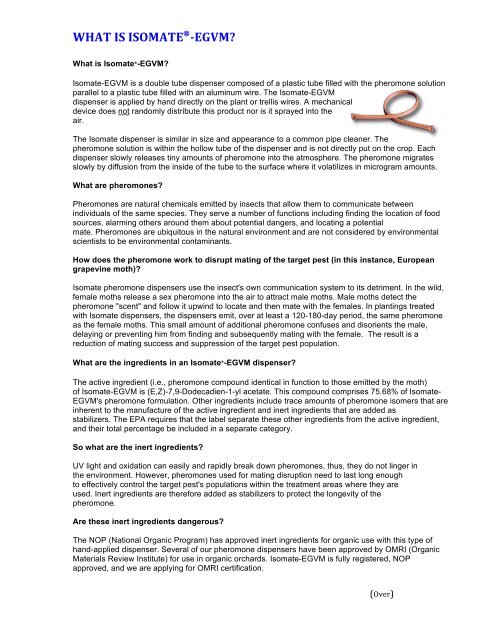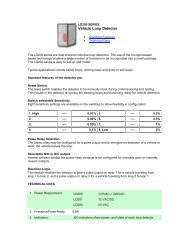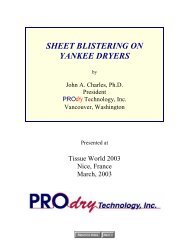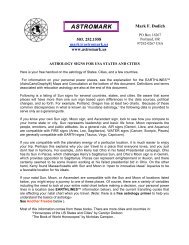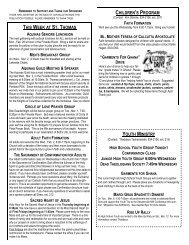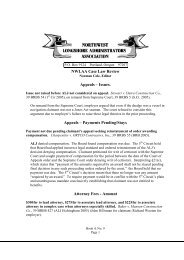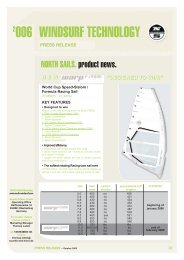WHAT IS ISOMATE-EGVM? - Pacific Biocontrol Corporation
WHAT IS ISOMATE-EGVM? - Pacific Biocontrol Corporation
WHAT IS ISOMATE-EGVM? - Pacific Biocontrol Corporation
Create successful ePaper yourself
Turn your PDF publications into a flip-book with our unique Google optimized e-Paper software.
<strong>WHAT</strong> <strong>IS</strong> <strong>IS</strong>OMATE ® -<strong>EGVM</strong>? <br />
What is Isomate ® -<strong>EGVM</strong>?<br />
Isomate-<strong>EGVM</strong> is a double tube dispenser composed of a plastic tube filled with the pheromone solution<br />
parallel to a plastic tube filled with an aluminum wire. The Isomate-<strong>EGVM</strong><br />
dispenser is applied by hand directly on the plant or trellis wires. A mechanical<br />
device does not randomly distribute this product nor is it sprayed into the<br />
air.<br />
The Isomate dispenser is similar in size and appearance to a common pipe cleaner. The<br />
pheromone solution is within the hollow tube of the dispenser and is not directly put on the crop. Each<br />
dispenser slowly releases tiny amounts of pheromone into the atmosphere. The pheromone migrates<br />
slowly by diffusion from the inside of the tube to the surface where it volatilizes in microgram amounts.<br />
What are pheromones?<br />
Pheromones are natural chemicals emitted by insects that allow them to communicate between<br />
individuals of the same species. They serve a number of functions including finding the location of food<br />
sources, alarming others around them about potential dangers, and locating a potential<br />
mate. Pheromones are ubiquitous in the natural environment and are not considered by environmental<br />
scientists to be environmental contaminants.<br />
How does the pheromone work to disrupt mating of the target pest (in this instance, European<br />
grapevine moth)?<br />
Isomate pheromone dispensers use the insect's own communication system to its detriment. In the wild,<br />
female moths release a sex pheromone into the air to attract male moths. Male moths detect the<br />
pheromone "scent" and follow it upwind to locate and then mate with the females. In plantings treated<br />
with Isomate dispensers, the dispensers emit, over at least a 120-180-day period, the same pheromone<br />
as the female moths. This small amount of additional pheromone confuses and disorients the male,<br />
delaying or preventing him from finding and subsequently mating with the female. The result is a<br />
reduction of mating success and suppression of the target pest population.<br />
What are the ingredients in an Isomate ® -<strong>EGVM</strong> dispenser?<br />
The active ingredient (i.e., pheromone compound identical in function to those emitted by the moth)<br />
of Isomate-<strong>EGVM</strong> is (E,Z)-7,9-Dodecadien-1-yl acetate. This compound comprises 75.68% of Isomate-<br />
<strong>EGVM</strong>'s pheromone formulation. Other ingredients include trace amounts of pheromone isomers that are<br />
inherent to the manufacture of the active ingredient and inert ingredients that are added as<br />
stabilizers. The EPA requires that the label separate these other ingredients from the active ingredient,<br />
and their total percentage be included in a separate category.<br />
So what are the inert ingredients?<br />
UV light and oxidation can easily and rapidly break down pheromones, thus, they do not linger in<br />
the environment. However, pheromones used for mating disruption need to last long enough<br />
to effectively control the target pest's populations within the treatment areas where they are<br />
used. Inert ingredients are therefore added as stabilizers to protect the longevity of the<br />
pheromone.<br />
Are these inert ingredients dangerous?<br />
The NOP (National Organic Program) has approved inert ingredients for organic use with this type of<br />
hand-applied dispenser. Several of our pheromone dispensers have been approved by OMRI (Organic<br />
Materials Review Institute) for use in organic orchards. Isomate-<strong>EGVM</strong> is fully registered, NOP<br />
approved, and we are applying for OMRI certification.<br />
(Over)
<strong>WHAT</strong> <strong>IS</strong> <strong>IS</strong>OMATE ® -<strong>EGVM</strong>? <br />
What about the plastic dispenser?<br />
The double tube dispenser is made of a polyethylene plastic. One side of the double tube contains a thin<br />
piece of aluminum wire, which assures that the dispenser will stay as applied throughout the season, and<br />
the other side contains 0.0097 fluid ounces of the pheromone.<br />
How will this product be deployed in and near vineyards?<br />
The dispensers will be twisted by hand to either the host plant branches, e.g. grapevine, or to the trellis<br />
wires in the canopy tops of the grapevine. 200 dispensers will be applied uniformly per acre in the<br />
infested areas. To prevent moth infestation from outside sources, application of the dispensers beyond<br />
the borders of the pest-infested areas may be advised. These may include areas where other host plants<br />
(e.g. wild grapevines, olive trees, berry crops) may be present. Mating disruption works in as little as a 10<br />
acre block; however, the larger the treated area the better the results. Area-wide applications are best.<br />
What precautions should be taken when handling the product?<br />
Straight chain lepidopteran pheromones have shown that they can be slightly irritating to the skin and<br />
eyes in test animals. Therefore, the label and MSDS instructs those who handle the product to wear<br />
gloves and protective eyewear when applying the product. After handling, they are to wash thoroughly<br />
with soap and water. Clothing should be washed that has been worn while handling the product. We<br />
have not had any safety issues with the use of our products over the 20+ years that our products have<br />
been used worldwide.<br />
What is the primary objective of using pheromones?<br />
These pheromone formulations were developed for and are used mainly in agriculture. The primary<br />
objective is to aid in the production of high quality, pest-free crops using economically viable and<br />
ecologically sound methods of pest control with minimal use of insecticides. When using mating<br />
disruption, the reduction or elimination of insecticides for insect control will help preserve and increase<br />
beneficial insects, spiders and predatory mites thereby enhancing the biological control of secondary<br />
pests and further reducing the need for insecticide sprays. With repeated yearly use, Isomate products<br />
can greatly reduce the population density of targeted insects in the crop environment while significantly<br />
reducing and in some cases eliminating the need for additional pesticides.<br />
In conclusion:<br />
Isomate-<strong>EGVM</strong> is a double tube dispenser that is hand<br />
applied to the plant or trellis wire. Unlike some<br />
pheromone products, it is not an aerosol or<br />
microencapsulated sprayable and therefore does not<br />
come in direct contact with the fruit. The pheromone only<br />
enters the environment as a volatile after diffusing in very<br />
small amounts from the dispenser. In other words, the<br />
active ingredient is contained internally in the dispenser<br />
and is slowly released into the air. Inert ingredients<br />
are added to prevent the premature breakdown of the<br />
pheromone active ingredient by outside forces (UV light<br />
and oxidation). Our goal with this product and our other<br />
pheromone dispensers is to minimize environmental<br />
damage and health risks associated with pest<br />
management and at the same time allow growers to<br />
provide consumers with food products that are free of pesticide residues.<br />
For further information contact <strong>Pacific</strong> <strong>Biocontrol</strong> <strong>Corporation</strong> (www.pacificbiocontrol.com).


